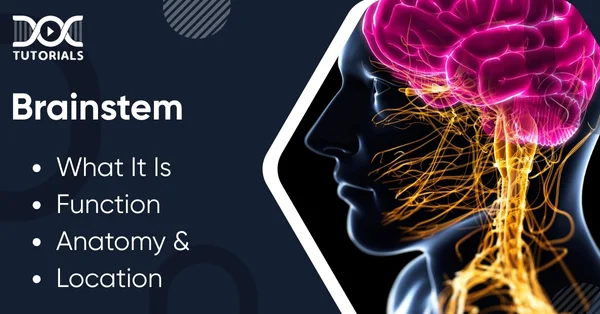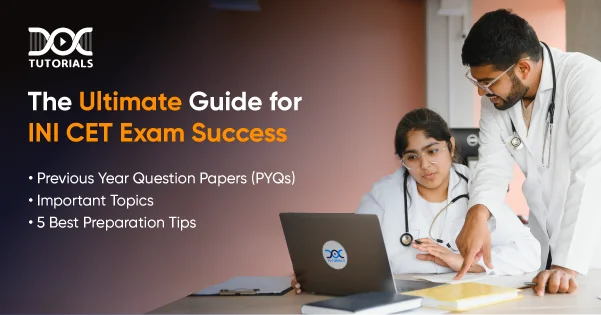Brainstem: What It Is, Function, Anatomy & Location

The brainstem is the lowest part of the brain, which connects the cerebrum to the cerebellum and spinal cord. It regulates fundamental life processes like consciousness and heart rate. It consists of significant grey and white matter areas and holds ten of the twelve cranial nerves vital for neurological function.
If you’re an aspiring NEET PG candidate, it is important to master the anatomy of the brainstem and its pathways. DocTutorials provides a tailored, high-yield program explicitly designed to help you prepare and excel in your NEET PG exam.
Keep reading to learn more about the brainstem parts and functions, anatomy, location, and more.
What is the Brainstem?
The brainstem is a stalk-like part of the brain that bridges its base, connecting the spinal cord and cerebellum with the cerebrum. It consists of 3 general divisions, from superior to inferior: the midbrain, pons, and medulla oblongata. The brainstem controls conscious and unconscious processes, such as breathing, heart rate, blood pressure, sleep, and consciousness.
Every component of the brainstem is unique in anatomy and function—the midbrain serves as a communications link, the pons links the cerebrum and cerebellum, and the medulla maintains essential reflexes and nerve tracts.
What are the Functions of the Brainstem?
The brainstem is a crucial part of the brain, regulating most automatic and necessary bodily functions. Below are the main brainstem functions, presented in concise pointers:
- Regulation of Vital Functions
The brainstem regulates vital life-sustaining functions such as heartbeat, respiration, and blood pressure management. Brainstem parts comprise neural circuits responsible for regulating involuntary movements necessary for survival.
- Motor and Sensory Control
It regulates motor movements through motor fibres and cranial nerves, such as facial expressions, eye movement, and tongue movement. It also processes sensory input about facial sensations, hearing, and balance.
- Reflexes and Balance
The brainstem regulates balance and posture and is integral to mediating reflex activities like coughing, gagging, and swallowing.
- Neurotransmitter Synthesis
Some nerves in the brainstem synthesise key neurotransmitters, including norepinephrine, which affects arousal, alertness, and autonomic processes. These chemical messengers assist in regulating communication among brain areas.
- Cranial Nerve Regulation
The brainstem has specific cranial nerves that control vital sensory and motor activities. These nerves transmit signals to and from the head and neck, facilitating the senses of vision, smell, and taste, facial sensations, swallowing, and the movements of the face, eyes, head, shoulders, and tongue.
- Pathway of Neural Communication
Serving as a doorway between the spinal cord and the brain, the brainstem facilitates effortless conveyance and integration of motor and sensory information, thus playing an instrumental role in overall body coordination through the central nervous system (CNS).
What is the Anatomy of the Brainstem?
The brainstem consists of 3 significant components with distinct anatomical and functional responsibilities. Following is a brief overview:
- Midbrain
The superior section of the brainstem, the midbrain (mesencephalon), regulates motor activities, particularly eye movement. It is also responsible for vision, hearing, and pain inhibition. It contains the oculomotor (III) and trochlear (IV) cranial nerve nuclei and interfaces with the diencephalon and the pons.
- Pons
The middle segment of the brainstem, formed from the metencephalon, is the pons. It links different brain parts and integrates facial sensations and movements, eye movement, hearing, and equilibrium.
It has nuclei for cranial nerves V (trigeminal), VI (abducens), VII (facial), and VIII (vestibulocochlear), and also has significant functions in breathing control through motor nuclei.
- Medulla Oblongata
The bottom of the brainstem, developed from the myelencephalon, the medulla, regulates breathing, heart rate, blood pressure, swallowing, and speech. It contains cranial nerves IX (glossopharyngeal), X (vagus), XI (accessory), and XII (hypoglossal), and has pivotal respiratory centres—the dorsal and ventral respiratory groups.
- Reticular Formation
Located within the brainstem tegmentum, this cluster of neurons is responsible for alertness, consciousness, and autonomic control. It coordinates the afferent and efferent signals within the CNS and keeps the mental state and homeostasis intact.
- Laminae of the Brainstem
The brainstem has 3 structural layers: tectum (posterior), tegmentum (middle), and basis (anterior). Each lamina carries particular pathways and nuclei, operating in dorsoventral order.
- Vascular Supply
The vertebrobasilar system mainly supplies the brainstem with blood. The basilar artery is formed by the vertebral arteries that supply critical branches such as the posterior inferior cerebellar artery (PICA), anterior inferior cerebellar artery (AICA), and superior cerebellar artery to provide adequate oxygenation and functioning.
- Decussations and Tracts
Decussations (interchange) occur at the cervicomedullary junction, including those of the pyramidal tracts, medial lemniscus, and trigeminal lemniscus, to help motor and sensory information cross. Corticobulbar tracts from the cortex that descend control voluntary movement and modify the function of cranial nerves.
- Reticular Activating System (RAS)
Part of the brainstem, the RAS cooperates with the thalamus to modulate wakefulness, attention, and sleep-wake patterns, vital for consciousness and function.
Where is the Brainstem Located?
The brainstem is located at the bottom of the brain, just above the spinal cord. The midbrain is the uppermost part of the brainstem. Its top is connected to the diencephalon, and its bottom connects to the pons. The brain stem is connected to the cerebellum.
The pons refers to the middle part of the brainstem. It connects to the midbrain situated above and the medulla oblongata located below. The medulla oblongata acts as a bridge between the pons and the spinal cord. Neurons in the medulla oblongata run through a considerable part of your body, encompassing most internal organs.
FAQs About Brainstem
- Is the brain stem the control centre?
The brainstem is an automatic control centre for many of the body’s essential involuntary functions, such as heartbeat, breathing, blood pressure, and many reflexes.
- What happens if the brainstem stops working?
If the brain stem stops functioning, the person will not be able to wake up or recover, and will enter a stage called ‘brain death’.
- What is the lower part of the brainstem?
The medulla oblongata, or simply the medulla, is the lower part of the brainstem, which is connected with the spinal cord.
- What are the parts of the brainstem?
The main structures of the brainstem are the hindbrain and midbrain. The substructures of the midbrain and hindbrain, i.e., the cerebellum, pons, and medulla oblongata, together constitute the brainstem.
- What tests evaluate the health of the brainstem?
Imaging tests like an MRI (Magnetic Resonance Imaging) are more informative than CT (Computed Tomography) scans in diagnosing problems in the brainstem. Brainstem Auditory Evoked Potentials (BAEPs) also provide information about the brainstem’s functioning.
Conclusion
Understanding the brainstem—its divisions, nuclei, tracts, and essential functions—is necessary for clinical mastery and NEET PG success. It has a pivotal place in the nervous system, regulating autonomic functions and transmitting sensory and motor pathways.
If you’re a medical student preparing for the NEET PG exam, it’s essential to understand its intricate anatomy and clinical importance. That is where DocTutorials provides complete NEET PG study material, video lectures guided by experts, and smart resources to empower your medical career through goal-oriented learning and accurate exam preparation.
Join DocTutorials to check out our NEET PG course today!
Latest Blogs
-

NEET PG Exam 2025- Date, Pattern, Marking Scheme, Subject Wise Weightage, and Exam Mode
NEET PG Exam 2025 is the ultimate gateway for medical graduates aspiring to pursue postgraduate courses in medicine, including MD,…
-

INI CET Exam 2025: Your Roadmap to Success – Key Topics, Strategies, and Lessons from Last Year’s Papers
The INI CET exam is more than just a test; it’s a significant milestone for many medical students aiming to…
-

INI CET Exam Success: Previous Year Question Papers & Ultimate Guide – INI CET PYQ
One can feel overwhelmed while preparing for the INI CET (Institute of National Importance Combined Entrance Test). A vast syllabus,…




